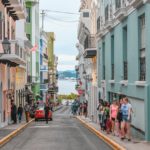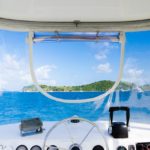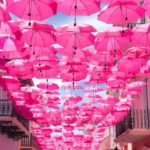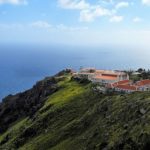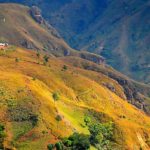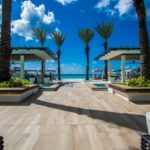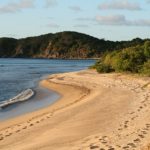After the Storm in Puerto Rico, Music

Music filled the airport, pulsed out of taxis and Ubers, and poured onto sidewalks from restaurants. Here and there, Puerto Ricans of all ages shimmied shoulder, singing aloud. A humid mid-summer haze lingered over San Juan. Tropical Storm Beryl lurked beyond the coastline. Yet it was hustle, not hysteria, propelling Puerto Ricans forward, with an occasional hip shake and a Reggaetón soundtrack.
As I prepared to visit Puerto Rico in mid-July, ten months after Hurricane Maria, neighbors and family asked me questions ranging from the primary, “Is Puerto Rico open for tourism now?” to the specific, “Do the hotels have electricity, is the water drinkable?” to the apocalyptic, “Is the airport open, is anything still standing?”
As an aid worker, I’m accustomed to the questions posed by close friends and relatives about my destinations abroad. I’ve worked in developing countries, areas emerging from conflict, and war zones. Puerto Rico doesn’t require a visa, vaccine or passport, and the flight from Atlanta is three quick hours. A bucket bath won’t scare me. If the roads aren’t mined, and no one’s shooting at me, I’m good. If there’s rum, I’m fabulous.
I convinced one of my best friends and fellow aid worker, Jen, to take our annual girls’ trip in Puerto Rico. We wanted for our tourist dollars to help the economy recover. Jen, unlike me, likes her vacations more luxurious than ceasefires and fieldwork. She seeks out hot showers, comfortable mattresses, and ice cream. We compromised on San Juan as a destination, with day trips.
Within 24 hours of our arrival, Jen and I overheard several aggressive interrogations of Puerto Ricans from other tourists fresh from the mainland. At the taxi stand, in shops, hotel lobbies, in museums, and on boats, I observed a pattern that repeated itself during the visit. A sigh, a dimming of the eyes as the targeted Puerto Rican’s smile fixed in place as they recounted their post-Hurricane Maria traumas and losses.
It was hustle, not hysteria, propelling Puerto Ricans forward, with an occasional hip shake and a Reggaetón soundtrack.
Responsive and polite, Puerto Ricans’ continued employment often depends on steady tourism. Since Hurricane Maria, rebuilding tourism required them to engage in a strange exchange of dollars for details of losses of property, family, livelihood or personal safety. As aid workers on vacation, we too were curious about the situation. Jen and I can’t turn that part of our brain off entirely, but we weren’t in San Juan to conduct a baseline survey or open a field office.
We understood that Puerto Ricans are not impromptu raconteurs of a generational trauma. Aid workers often encounter post-crisis fatigue in areas emerging from conflict and natural disasters. Once the supplies are distributed, roads cleared, and the journalists depart, local residents tire of surveys. They resent recounting the losses, the dead, and the uncertainty of the future.
We didn’t ask for an update on the obvious. San Juan’s reconstruction veined the sky-line in networks of blue tarps, missing shingles, and scaffolding. Yet people got on with it, as people do. In our lodging, the Hotel El Convento, a Puerto Rican wedding party filled the lobby with music and the sounds of celebration. A testament to an island determined to recover, the bride-to-be resplendent with red lips and a flower tucked in her hair.
Pedestrians, sight-seers, businessmen and women rushed to and from, bartenders and baristas poured. The island hummed with activity, a serenade constant as vehicles and shops mixed vocalists and eras, Héctor Lavoe blended with Daddy Yankee and Lleana Cabra. This is what the islanders wanted to share with their guests—the culture, indomitable and weatherproof.
If the roads aren’t mined, and no one’s shooting at me, I’m good. If there’s rum, I’m fabulous.
While walking the stone walls of the Castillo San Cristóbal and Castillo San Felipe del Morro fortresses, eating ice cream at Senor Paleta, snorkeling at Culebra, we gleaned details of Puerto Rico’s recovery by polite observation and, sometimes, by first sharing our own experiences as aid workers and receiving stories in return. The most common refrain of, “We can take anything now,” peppered our conversations with kayak guides, boat captains, and students working two summer jobs. “Tropical Storm Beryl, I’ll stuff it in an empanada and eat it,” said another.
At Bacardi’s main distillery we toured, paid our respects to the black bat of good luck, and stocked up in the gift shop. Bacardi contributed to the recovery in funds, a musical concert, employment, and planned to power through 365 days without respite or maintenance to recoup. Its employees were stoic and unafraid of the current hurricane season.
The Puerto Ricans with whom we were able to speak didn’t express the level of bitterness often portrayed by mainland news networks. However, an oft-repeated lament focused on the ignorance of Puerto Rico’s level of development, and that the mainland authorities assumed an emergency response to the territory could be the same as that of a developed mainland city. We noticed buildings for sale or foreclosing, and schools closed. There remained many lingering issues, electricity to restore, and a death count too high to bear. The battered island carries on while its bruises are on display.
The courage of the territory reminded me of New York. As there is a pre and post-9/11 New Yorker, there is a pre and post-Hurricane Maria Puerto Rican. Among those residing in either location at the time of the event exists a similar sense that nothing short of annihilation could scare anyone who’d lived through it. An island of people otherwise in competition during the daily grind, Puerto Ricans demonstrated they’re stronger than what the ocean could lob at them.
Flash flood warnings lit up our phones as Tropical Storm Beryl passed by, dousing the island in rain and wind. While the storm stole our sunshine, we meandered the Poets Passage and ate empanadas at Pa’Pical in Isle Verde–where the manager sang out loud, pausing to shake a tail feather between serving the stuffed meat pies and Bacardi and coke. During the recovery, he made empanadas for relief workers, and everyone wrote on his walls. He sent us to the place he always sends tourists when it rains, the Plaza las Americas, for a movie and smooth but hair-raising coffee at the Casa Norberto Books and Cafe Bar.
A dance contest on the main floor of the plaza distracted us from challenging our linguistic skills by watching Ant-Man in Spanish. Because who has the attitude to drop it low while a tropical storm dumps nerve crushing levels of precipitation? Puerto Ricans, claro. We may not outwit the coming storms, but the island’s residents could teach us all how to recover from weather extremes with realism, strong coffee, and musical fortitude.
The courage of the territory reminded me of New York. As there is a pre and post-9/11 New Yorker, there is a pre and post-Hurricane Maria Puerto Rican.
The trip continued to the interior of the island near El Yunque National Forest and the resurgent bioluminescent bays. Heavy with decay and rebirth, Puerto Rico’s tropical wilderness showed signs of regeneration, bright flowers and green shoots reappeared, iguanas tangled in mangrove branches crawling with large red crabs and frogs.
On the last day, a talkative Uber driver, also an artist and bartender, gave us a tour of the beautiful grittiness of Santurce’s street art. An exciting neighborhood to explore, Santurce offered the Hacienda San Pedro Café, the Museo de Arte de Puerto Rico and urban photography options as the cars thumped by playing salsa, merengue, bomba or some good “Nuyorican” Jennifer Lopez.
The last Uber driver thanked us for visiting, then warned us in Spanglish. “You come back Puerto Rico, but no come back September… eh? September Puerto Rico no bueno for de tourists. The other seasons… muy bueno, you come back, eh?” Yes. We’ll come back. And we’ll tell everyone to come back too.

